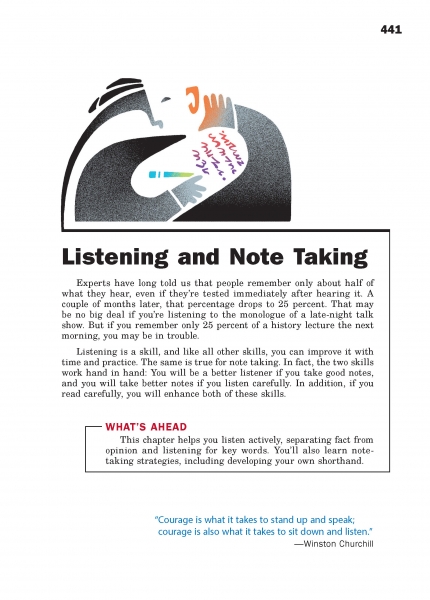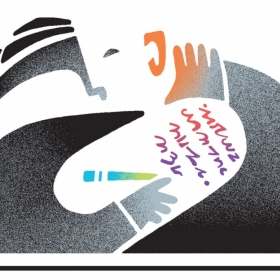Page 441 from

Start Up Activity
Tell students you want them to take very careful notes about what you are going to say next. Then think of a student in the class with whom you have a good rapport and rapidly say the following (using the correct name and gendered pronouns, of course):
“I guess Maylee thinks she knows what I had for lunch yesterday, and she thinks it's the same thing many of you suspect that I have every day, but I think she is wrong, and I know most of you think I am right.“
After students finish taking their notes, ask for a volunteer to give you the gist of what you just said. Ask the rest of the class if they agree with the version the student has provided. Have students offer any additions or corrections. Then share the original statement once again (and be ready to tell students what you had for lunch yesterday).
Tell students they've just endured a boot-camp in listening and note taking. Sometimes lectures provide many details at a considerable clip, and students have to accurately record the gist and recall it later. This chapter will help with both sides of the issue: listening and note taking.
Think About It
“Education is the ability to listen to almost anything without losing your temper or your self-confidence.”
—Robert Frost

Start Up Activity
Tell students you want them to take very careful notes about what you are going to say next. Then think of a student in the class with whom you have a good rapport and rapidly say the following (using the correct name and gendered pronouns, of course):
“I guess Maylee thinks she knows what I had for lunch yesterday, and she thinks it's the same thing many of you suspect that I have every day, but I think she is wrong, and I know most of you think I am right.“
After students finish taking their notes, ask for a volunteer to give you the gist of what you just said. Ask the rest of the class if they agree with the version the student has provided. Have students offer any additions or corrections. Then share the original statement once again (and be ready to tell students what you had for lunch yesterday).
Tell students they've just endured a boot-camp in listening and note taking. Sometimes lectures provide many details at a considerable clip, and students have to accurately record the gist and recall it later. This chapter will help with both sides of the issue: listening and note taking.
Think About It
“Education is the ability to listen to almost anything without losing your temper or your self-confidence.”
—Robert Frost




